Discover Florida Nature
It's time to explore the natural Florida


|
|
|
|
|
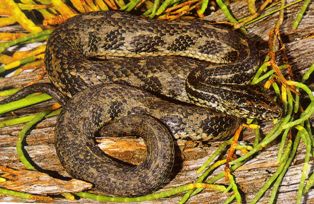 Atlantic
Salt Marsh Snake- The Atlantic salt marsh snake is a slender,
heavily keeled water snake about 2 feet in total length, with a pattern
of stripes that are variously broken into blotches. The dorsal ground
color is pale olive, patterned with a pair of dark brown stripes running
down the back and enclosing a pale mid-dorsal stripe. These dark stripes
usually become fragmented posteriorly into a series of elongate
blotches. There is also a row of dark blotches along the lower sides of
the body, which merge to form stripes in the neck region. The ventral
surface is black with a median series of yellowish spots. This snake
feeds on small fish in shallow water. It is most active at night, during
periods of low tide. Atlantic
Salt Marsh Snake- The Atlantic salt marsh snake is a slender,
heavily keeled water snake about 2 feet in total length, with a pattern
of stripes that are variously broken into blotches. The dorsal ground
color is pale olive, patterned with a pair of dark brown stripes running
down the back and enclosing a pale mid-dorsal stripe. These dark stripes
usually become fragmented posteriorly into a series of elongate
blotches. There is also a row of dark blotches along the lower sides of
the body, which merge to form stripes in the neck region. The ventral
surface is black with a median series of yellowish spots. This snake
feeds on small fish in shallow water. It is most active at night, during
periods of low tide. 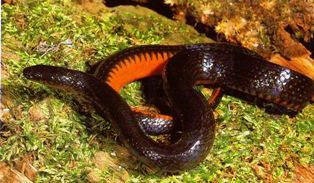 Black
Swamp Snake- Black swamp snakes are found in the Coastal Plain
of the southeastern United States from eastern North Carolina to
southern Alabama and throughout Florida. Black swamp snakes are fairly
small, reaching a maximum length of around 22 inches. These highly
aquatic snakes are glossy black with bright red bellies. Within the
water, black swamp snakes are active both during the day and at night
and actively forage amidst submerged vegetation. Because black swamp
snakes are highly aquatic and extremely secretive they are seldom seen,
even by experienced herpetologists. A variety of aquatic prey have been
recorded in the diet of swamp snakes, including small fish, tadpoles,
and small frogs. Black
Swamp Snake- Black swamp snakes are found in the Coastal Plain
of the southeastern United States from eastern North Carolina to
southern Alabama and throughout Florida. Black swamp snakes are fairly
small, reaching a maximum length of around 22 inches. These highly
aquatic snakes are glossy black with bright red bellies. Within the
water, black swamp snakes are active both during the day and at night
and actively forage amidst submerged vegetation. Because black swamp
snakes are highly aquatic and extremely secretive they are seldom seen,
even by experienced herpetologists. A variety of aquatic prey have been
recorded in the diet of swamp snakes, including small fish, tadpoles,
and small frogs.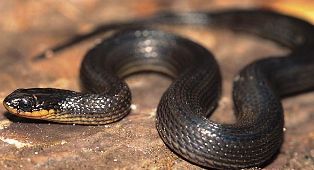 Glossy
Crayfish Snake- Glossy crayfish snakes are mid-sized, highly
aquatic snakes, ranging in length from 14 to 24 inches. The glossy
crayfish snake is found in the Coastal Plain of the southeastern United
States from eastern North Carolina to eastern Texas but is absent from
the southern portion of peninsular Florida. The crayfish snakes are
highly aquatic and inhabit a variety of wetland habitats including
cypress swamps. Because glossy crayfish snakes are highly aquatic and
extremely secretive they are seldom seen. The glossy crayfish snake is
of conservation concern throughout its range because its reliance on
aquatic habits makes it vulnerable to habitat destruction. Glossy
Crayfish Snake- Glossy crayfish snakes are mid-sized, highly
aquatic snakes, ranging in length from 14 to 24 inches. The glossy
crayfish snake is found in the Coastal Plain of the southeastern United
States from eastern North Carolina to eastern Texas but is absent from
the southern portion of peninsular Florida. The crayfish snakes are
highly aquatic and inhabit a variety of wetland habitats including
cypress swamps. Because glossy crayfish snakes are highly aquatic and
extremely secretive they are seldom seen. The glossy crayfish snake is
of conservation concern throughout its range because its reliance on
aquatic habits makes it vulnerable to habitat destruction.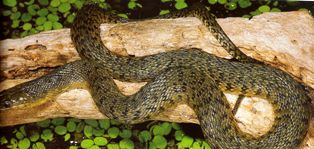 Florida
Green Water Snake- The Florida Green prefers weed-choked
marshes, is less inclined to bask, and is somewhat more nocturnal than
the Mississippi Green Water Snake. Despite its name, the green water
snake is not always conspicuous green. The Florida green water snake is
a heavy-bodied, olive-green, brownish, or reddish (in south Florida)
water snake, with indistinct dark bars on its sides and back. The
Florida Green Water Snake's head looks short and has a series of small
scales that separate the eyes from the upper lip scales. This snake's
belly is cream and unmarked. Feeding mainly on minnows and small fish,
the green water snake often bites aggressively when first handled, and
it also emits a nasty smelling musk Florida
Green Water Snake- The Florida Green prefers weed-choked
marshes, is less inclined to bask, and is somewhat more nocturnal than
the Mississippi Green Water Snake. Despite its name, the green water
snake is not always conspicuous green. The Florida green water snake is
a heavy-bodied, olive-green, brownish, or reddish (in south Florida)
water snake, with indistinct dark bars on its sides and back. The
Florida Green Water Snake's head looks short and has a series of small
scales that separate the eyes from the upper lip scales. This snake's
belly is cream and unmarked. Feeding mainly on minnows and small fish,
the green water snake often bites aggressively when first handled, and
it also emits a nasty smelling musk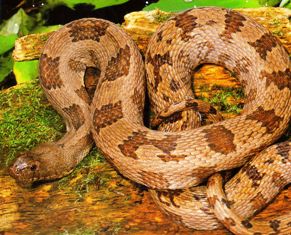 Brown
Water Snake- Brown Watersnakes are large, between 30 and 60
inches long. The brown watersnake is a somewhat heavy bodied aquatic
snake with light to dark brown coloring. This snake has large darker
brown square blotches throughout it body, with one line of square
blotches running down the center of the dorsum and two other lines
running in alternating rows along the sides of the snake. The belly is
usually light with brown splotches and black crescents. Brown
watersnakes have strongly keeled scales and its head is visibly wider
than its neck, giving this snake a slightly triangular appearance.
Female brown watersnakes are much larger than males. Brown watersnakes
are excellent swimmers and feed primarily on fish, particularly small
catfish, which they capture either by ambush or by actively foraging
along the edges or bottom of rivers and lakes. Brown watersnakes are
also proficient climbers and often bask on vegetation or emergent snags
up to 20 ft above the water. If startled, they will drop from their
perch into the water and may accidentally end up in a passing boat. Brown
Water Snake- Brown Watersnakes are large, between 30 and 60
inches long. The brown watersnake is a somewhat heavy bodied aquatic
snake with light to dark brown coloring. This snake has large darker
brown square blotches throughout it body, with one line of square
blotches running down the center of the dorsum and two other lines
running in alternating rows along the sides of the snake. The belly is
usually light with brown splotches and black crescents. Brown
watersnakes have strongly keeled scales and its head is visibly wider
than its neck, giving this snake a slightly triangular appearance.
Female brown watersnakes are much larger than males. Brown watersnakes
are excellent swimmers and feed primarily on fish, particularly small
catfish, which they capture either by ambush or by actively foraging
along the edges or bottom of rivers and lakes. Brown watersnakes are
also proficient climbers and often bask on vegetation or emergent snags
up to 20 ft above the water. If startled, they will drop from their
perch into the water and may accidentally end up in a passing boat. Florida
Water Snake- This common and often beautiful aquatic snake is
sometimes seen on roadways during rainy weather. Adult Florida Water
Snakes average from 24-42 inches in length and are stout bodied snakes
with black, brown, or red crossbands (often bordered with black) across
back, which may be obscured as the snake darkens with age. Background
color on the Florida water snake may be gray, yellow, tan, or reddish.
Also called the Florida Banded Water Snake, it feeds on mainly fish and
frogs. The Florida Water Snake lives in rivers, lakes, ponds and
ditches, and is often seen sunning itself on river and lake edges, or in
overhanging bushes. Banded water snakes are often mistaken for the
venomous cottonmouth or water moccasin, as these two species look very
similar, but you can usually tell them apart by their behavior. Florida
Water Snake- This common and often beautiful aquatic snake is
sometimes seen on roadways during rainy weather. Adult Florida Water
Snakes average from 24-42 inches in length and are stout bodied snakes
with black, brown, or red crossbands (often bordered with black) across
back, which may be obscured as the snake darkens with age. Background
color on the Florida water snake may be gray, yellow, tan, or reddish.
Also called the Florida Banded Water Snake, it feeds on mainly fish and
frogs. The Florida Water Snake lives in rivers, lakes, ponds and
ditches, and is often seen sunning itself on river and lake edges, or in
overhanging bushes. Banded water snakes are often mistaken for the
venomous cottonmouth or water moccasin, as these two species look very
similar, but you can usually tell them apart by their behavior.
|
|
|
Advertise | Privacy Statement | Dog Encyclopedia | Video |Contact | Alaska Nature |
|